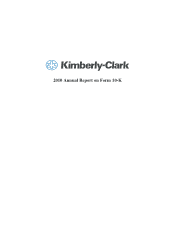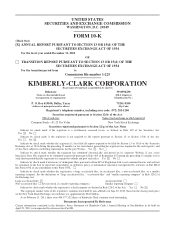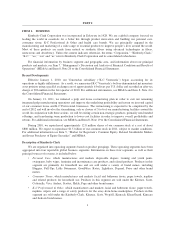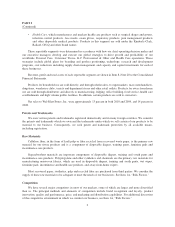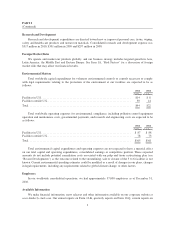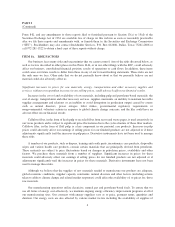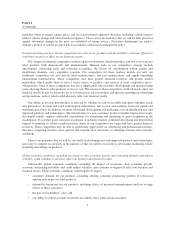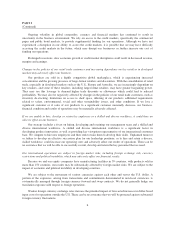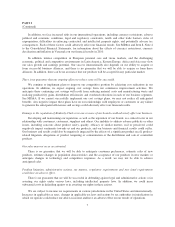Kimberly-Clark 2010 Annual Report Download - page 8
Download and view the complete annual report
Please find page 8 of the 2010 Kimberly-Clark annual report below. You can navigate through the pages in the report by either clicking on the pages listed below, or by using the keyword search tool below to find specific information within the annual report.
PART I
(Continued)
Form 8-K, and any amendments to those reports filed or furnished pursuant to Section 13(a) or 15(d) of the
Securities Exchange Act of 1934 are available free of charge on this website as soon as reasonably practicable
after we file these reports and amendments with, or furnish them to, the Securities and Exchange Commission
(“SEC”). Stockholders may also contact Stockholder Services, P.O. Box 612606, Dallas, Texas 75261-2606 or
call 972-281-1522 to obtain a hard copy of these reports without charge.
ITEM 1A. RISK FACTORS
Our business faces many risks and uncertainties that we cannot control. Any of the risks discussed below, as
well as factors described in other places in this Form 10-K, or in our other filings with the SEC, could adversely
affect our business, consolidated financial position, results of operations or cash flows. In addition, these items
could cause our future results to differ from those in any of our forward-looking statements. These risks are not
the only ones we face. Other risks that we do not presently know about or that we presently believe are not
material could also adversely affect us.
Significant increases in prices for raw materials, energy, transportation and other necessary supplies and
services, without corresponding increases in our selling prices, could adversely affect our financial results.
Increases in the cost of and availability of raw materials, including pulp and petroleum-based materials, the
cost of energy, transportation and other necessary services, supplier constraints, an inability to maintain favorable
supplier arrangements and relations or an inability to avoid disruptions in production output caused by events
such as natural disasters, power outages, labor strikes, governmental regulatory requirements or
nongovernmental voluntary actions in response to global climate change concerns, and the like could have an
adverse effect on our financial results.
Cellulose fiber, in the form of kraft pulp or recycled fiber from recovered waste paper, is used extensively in
our tissue products and is subject to significant price fluctuations due to the cyclical nature of these fiber markets.
Cellulose fiber, in the form of fluff pulp, is a key component in our personal care products. Increases in pulp
prices could adversely affect our earnings if selling prices for our finished products are not adjusted or if these
adjustments significantly trail the increases in pulp prices. Derivative instruments have not been used to manage
these risks.
A number of our products, such as diapers, training and youth pants, incontinence care products, disposable
wipes and various health care products, contain certain materials that are principally derived from petroleum.
These materials are subject to price fluctuations based on changes in petroleum prices, availability and other
factors. We purchase these materials from a number of suppliers. Significant increases in prices for these
materials could adversely affect our earnings if selling prices for our finished products are not adjusted or if
adjustments significantly trail the increases in prices for these materials. Derivative instruments have not been
used to manage these risks.
Although we believe that the supplies of raw materials needed to manufacture our products are adequate,
global economic conditions, supplier capacity constraints, natural disasters and other factors (including actions
taken to address climate change and related market responses) could affect the availability of, or prices for, those
raw materials.
Our manufacturing operations utilize electricity, natural gas and petroleum-based fuels. To ensure that we
use all forms of energy cost-effectively, we maintain ongoing energy efficiency improvement programs at all of
our manufacturing sites. Our contracts with energy suppliers vary as to price, payment terms, quantities and
duration. Our energy costs are also affected by various market factors including the availability of supplies of
4

